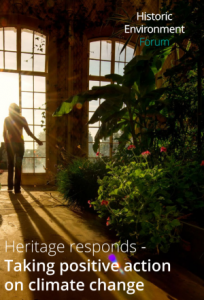 The UK heritage sector is united in its pioneering response to climate change, according to Heritage Responds, a new report launched this week by heritage coalition the Historic Environment Forum charting how heritage organisations are taking positive action.
The UK heritage sector is united in its pioneering response to climate change, according to Heritage Responds, a new report launched this week by heritage coalition the Historic Environment Forum charting how heritage organisations are taking positive action.
image: Heritage Responds PDF download
… What Heritage Responds clearly demonstrates is the proactive work of so many organisations across the heritage sector to find solutions…
The HEF writes (summarised):
The report brings together the expertise of 26 of the country’s leading heritage organisations – including English Heritage, Historic England and the National Trust – ahead of COP26 in Glasgow to highlight examples of how through revolutionary research, carbon reduction and maximising the potential of the historic environment, the heritage sector is making a major contribution to the response to climate change.
Rob Woodside, Chair of the Historic Environment Forum’s COP26 Task Group and English Heritage Estates Director said: ‘Heritage organisations are pioneering the sector’s response to climate change. Ahead of COP26, we wanted to share our experience of our sustainable response to the greatest challenge of our time. The case studies we have highlighted show not only how heritage organisations are responding to the impact of climate change, but also how we can be part of the solution.’
‘What Heritage Responds clearly demonstrates is the proactive work of so many organisations across the heritage sector to find solutions – leading on ground-breaking research, innovating on approaches to adaptation, harnessing the use of technology, retro-fitting historic buildings and reducing carbon emissions by retaining and reusing existing buildings. We are working across sectors to bring approaches to nature and culture closer together to help manage the green lungs in our cities and adapt to new environmental challenges. We’re also forging new skills to help maintain and adapt historic buildings. This isn’t about protecting the past but using heritage to find solutions for the future.’
The work is the culmination of six months of collaboration by the members of the Historic Environment Forum and showcases how the sector is responding to climate change, including investment in traditional low-carbon building adaptation techniques, nature-based solutions to mitigate future impacts, and renewed efforts to increase the lifespan of heritage assets and save the embodied carbon which might otherwise be sacrificed in demolition, new construction, or poor upkeep.
The case studies within the report highlight some of the UK’s leading projects to introduce sustainable solutions in the historic environment, including:
- The Grade II listed Art Deco Jubilee Pool in Penzance, the first lido in the UK to harness geothermal heating as part of a new scheme supported by the Architectural Heritage Fund opened in August 2020.
- A £2.5m project, co-led by National Trust and the Nidderdale Area of Outstanding Natural Beauty– aided by a £1.4m grant from National Lottery Heritage Fund – which will implement nature-based solutions to improve the resilience of the Skell Valley’s resilience to changing weather
- A £90m Grosvenor Britain & Ireland programme to reduce energy use and carbon emissions across their historic Mayfair and Belgravia portfolio by over 70% by 2030.
- A hidden array of 150 photovoltaic panels installed on the south-facing slope of Gloucester Cathedral’s medieval roof, supported by Historic England.
- Ingenious smart sensors being used to help protect the priceless art collection at English Heritage’s Kenwood House in North London.
- An innovative new heating scheme from the Church of England at Bath Abbey, using warmth recovered from Roman drains which carry the city’s hot spring water.
Historic Environment Forum Chair Dr Adrian Olivier said: ‘The Historic Environment Forum exists to bring people together. And there is no other single issue that requires us to work more closely together than climate change. As the world turns its eyes to COP26 in Glasgow, this work intends to highlight the positive contribution heritage organisations and their partners are making to the debate, the actions needed to adapt to a changing world, and how heritage itself is part of the solution. The work creates a fantastic repository of good practice, lessons learned and interaction between different groups and sectors that anyone can draw on. I’m grateful to all the organisations who have provided us with such a rich and diverse selection of material. Let’s continue to build on the positive progress we’ve already made.’
Historic England’s Chief Executive, Duncan Wilson said: ‘These case studies illustrate that the historic environment is a powerful catalyst for tackling the dual challenges of climate change – the need to deliver the transition to net zero and to adapt to a new climate. Our heritage is threatened by a changing climate with increasingly warmer, wetter winters, hotter, drier summers and rising sea levels. This report highlights inspiring solutions to help communities protect our historic places from these threats and drive down carbon emissions. We’re delighted to be part of a truly collaborative effort which is shaping a growing awareness globally that our cultural heritage has a crucial role to play in charting our way through the climate crisis.’…
Heritage Responds Climate Change Story Map is now live at https://storymaps.arcgis.com/stories/ecc889fe0294426c94a9e283a5ff7bb7… The Historic Environment Forum hopes that this selection of case studies begins to demonstrate the breadth of current activity and inspires further positive action. The case studies show how the heritage sector is acting to address climate change – and how heritage is part of the solution to climate change.
For more see the HEF website

